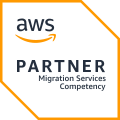Might as Well Modernize: Finding the Sweet Spot For Your Migration to AWS
By Brandon Prasnicki, Senior Solutions Cloud Architect
When considering moving workloads to the cloud, the process at first can be intimidating. There are many options and tools available in the AWS Cloud which can be leveraged to reduce cost, improve performance and make applications highly available. However, questions like “Where do I start?“, “Which AWS services do I choose?“, and “How do I even start to approach this effort?” may be overwhelming. To begin the journey, it is good to be aware of the various approaches you could take when migrating to the cloud. These are typically identified as The 6 R’s of Migration and are the foundation to a successful migration plan.
The first two options identified in the article – Rehosting and Replatforming are very common, and represent the majority of the migration projects we see here at TekStream. They tend to be the quickest way to take advantage of the what makes the cloud so appealing. Let’s dig deeper!
Rehosting
Rehosting, or lift-and-shift is a relatively quick and easy strategy. It shines brightest for single server workloads. By using the AWS Migration Service (MGN), one can quickly clone a server in a block replication fashion and launch it into AWS. Traditional 3-tier architectures can also be quickly moved. Public IP’s can be brought over, and/or quickly switched within an existing DNS provider to go live in a short period of time. DNS entries can also be moved to AWS Route 53 with little effort. Typically, only a few light modifications and testing efforts are necessary to go live with the workload. Even with this method, simple AWS features like stopping and starting instances can quickly lead to cost savings, and spending plans or reserve instances can reduce costs even further.
After evaluation, often we find additional easy wins that will enhance the workload. There are many AWS cloud features that can be leveraged without much effort and migration is the perfect time to identify these opportunities. The project effort and timeline can be more focused on improvements versus validating, testing and fixing issues to confirm ‘as is’ or ‘like functionality’ that can still exist in a lift-and-shift model. Also, depending on the size of the server and complexity of the workload, testing efforts and timelines can increase costs. MGN is creating point in time snapshots that can increase costs and cut into the quick and dirty rehosting/lift-and-shift benefit, and complex applications may have a large validation and fix effort. It may make the most sense to find some quick and easy workflows to move to the cloud during the migration effort.
Replatforming
Replatforming, or the lift-tinker-and-shift approach tends to give more bang for the buck. These wins may exist all throughout the workload, and once properly evaluated can be achieved without much effort. We have seen numerous projects where cost difference from Rehosting to Replatforming wasn’t substantial, and in fact ended up extending timelines because of unforeseen issues due to outdated legacy workloads. On the flip side, there are numerous examples of ‘getting a new and clean shiny toy’ that doesn’t add significant time to the project, and in general provides exponentially more value. Focusing project efforts on doing it right the first time vs retrofitting legacy workloads ends up showing much more value.
When it comes to identifying these quick wins, TekStream can help identify and talk you through the benefits vs. the effort required helping you drive decisions in a phased approach. Our project approach considers these upfront in a QuickStream which entails education, requirement gathering and discussion of your opportunities and then lays them out for you in a high-level design architecture diagram. This all happens before the project goes further in the development process. TekStream holds the AWS Migration Services Partner Competency and can even help fund your AWS migration. Read more about AWS Competencies and how our designation matters when you choose your migration partner.

Here are some examples of quick wins we often see in our migration projects:
EC2 Compute
EC2 compute is probably the most well-known AWS service. It can be a rather simple transition and is not too intimidating. Amazon Linux can often reduce compute costs in comparison to other Linux flavors such as Redhat, while still giving you a strong support foundation with AWS. In addition, a bit of functionality can be added that doesn’t add too much complexity. You can dramatically increase performance, resiliency and cost savings by leveraging EC2 load-balancing across multiple availability zones and auto-scaling instances horizontally. AWS Backup can be used to automate backups, for simple restore of compute instances and storage volumes, and various backup schedules and target resources can be defined by a well-defined tagging strategy. Other services can be leveraged to complement EC2 compute workloads such as Systems Manager and Patch Manager to automate OS patching and make application modifications or automate scheduled down times to further reduce costs.
Data Tier
RDS, Aurora and DynamoDB are AWS database services that offer easy scaling and operation management and automated version upgrades. Also, there are often times opportunities to eliminate DB vendor license fees such as moving from Oracle to Aurora Postgres.
Application Tier
Moving from Weblogic, or Websphere to Apache Tomcat can be very powerful in terms of ROI. Also, often a migration like this is a good opportunity to leverage CI/CD deployment strategies to make use of automated deployments and patching for application code. These deployments can be done all at once or in a blue/green fashion.
Many of these concepts were implemented by The Georgia Technology Authority (GTA) in their recent Portal Application Migration.
Not all projects are the same, and sometimes a hybrid approach may be best. For example, many times it makes sense to have the application layer moved with AWS migration service (MGN) and the DB migrated to RDS. TekStream guides your teamthrough the process of making decisions that best fit your objectives. TekStream can aid at any level of effort for a project. Perhaps some guidance is all that is needed, and your resources take the reins. Or, let TekStream work side-by-side with you for a successful migration. Some of our clients leave it all to us, and use AWS incentives to fund the project.
Where are you in the migration process, and how can we use our AWS expertise to help? Contact us to get started:

